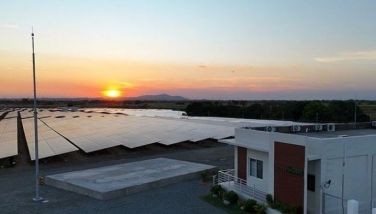Onions from China, anyone?
July 18, 2004 | 12:00am
Last June 9, Bureau of Plant Industry director Hernani Golez who was appointed only early this year issued permits for the importation of 120 containers of Chinese yellow onions, which at the price they are being brought in, could be the death blow to the local onion industry.
The permits were issued to 13 trading firms allegedly owned by only three notorious smugglers each of who gets 120 (40-ft) containers each. At least six of the allocatees have cases pending with the Bureau of Customs for importing onions and other vegetables without the necessary permit from the BPI last year and abandoning the goods.
Golez is reportedly acting on orders from the lady head of an unheard of association of vegetable importers and exporters who was given the power to decide when to allow importations and who to give the import permits to for and in behalf of the director. In fact, I have a copy of a letter from this lady to the BPI director informing him of the results of a meeting among vegetable importers and how the 120 containers will be distributed among the 13 companies. "Permit may now be allowed," the lady said in her letter to Golez.
Because of this untimely importation of this Chinese onions which were selling from P17 per kilo, the wholesale price of red onion has dropped from P25 per kilo ex cold storage to only P21 per kilo a month after the controversial import permits were issued.
According to Golez, the bureau will review the list of chosen importers after the two first two groups have completed the importation. As for other interested importers, he has asked them to "piggy-back" on the ‘chosen ones’ import permit allocation.
First of all, the country has just completed an unprecedented 2004 bountiful local onion harvest in May with almost 3.6 million bags or more than what we need. As of end-June, there are about 1.2 million bags of onion onion stock inventory in different cold storages in Nueva Ecija and Bulacan, not to mention about two million bags in other facilities in Pampanga and Metro Manila that are still unsold.
What is timely though is the release of the import permits which coincided with the start of onion harvest in mainland China, making the onions very abundant and cheap. And to think that we are talking about the Philippines’ plant industry bureau, not China’s wanting to increase the income of Chinese farmers.
The importation of Chinese onion at this time of the year will not allow any breathing space for local onion planters to convert onion stock into cash fund for the purchase of farm inputs needed preparatory for the coming early monsoon planting in September in Western Pangasinan.
So why is the BPI allowing these imported onions to come in? Your guess is as good as mine.
Dr. Edilberto D. Redoña, deputy executive director for R&D of the Philippine Rice Research Institute (PhilRice), has just delivered an interesting talk on rice biotechnology for Asian developing countries.
In his paper, Redoña noted that Asian rice production would need to increase from its current level of 545 million tons to 700 million tons by 2025 in order to feed an additional 650 million rice consumers while ensuring profitability for countless resource-poor farmers in Asia. In Asia, demand for rice is projected to increase by 70 percent over the next 30 years, driven primarily by population growth that, excluding China, is expected to increase by 51 percent. The Asian population is projected to increase from 3.7 billion in 2000 to 4.6 billion in 2025.
In the Philippines, 65 percent more rice has to be produced by 2025 to keep up with demand by a projected population of about 107 million, continually growing by 2.3 percent each year. To keep up with projected demand, he says rice production growth must be sustained at three percent year on year, if importation is to be avoided.
Given that annual rice production growth rates have been decelerating to less than two percent per year, and the land frontier is closing, major technological progress has to be achieved in the next two decades for the population demand for rice to be met locally.
Against the backdrop of decreasing land, labor, and water that can be devoted to rice production due to increasing competition from the non-farming sectors, the challenge to increase rice productivity is indeed enormous.
Rice biotechnology, which has progressed rapidly to a point where transgenic rices are about to be commercialized, can help address these major challenges of securing food security while alleviating poverty in Asia. New processes and second and third generation products are also in the pipeline that should result in greater relevancies of biotechnology research outputs and faster acceptance by both farmers and the general rice-consuming public.
He, however, noted that biotechnology is not a panacea for achieving food security and sustainability of rice-based agricultural systems in Asia. The technology must continue to draw its relevance from its being able to address the existing and projected problems of small rice farming communities and, at the same time, the food and health needs of more than half of the world’s population that consumes rice. Furthermore, products must be so designed such that they complement rather than replace existing practices and enrich rather than disrupt the agroenviroments for which they are targeted for deployment.
The tasks that remain are gargantuan and the future, particularly for transgenic rice in Asia, is still uncertain, Redona pointed out. According to him, what is needed is the full engagement of and dialogues amongst all stakeholders at all levels. New modalities of collaborations need to be explored. Asia must draw its lessons from the cumulative experience in the developed world.
Programs that stimulate open discussions and enable concerted and cooperative efforts to be made on the safe and relevant use of rice biotechnologies must be supported. Only then can the impact of science, in general, and biotechnology, in particular, on the lives of the poor in Asia, through the attainment of a stable and sustainable rice-based agriculture and household food and economic security, be maximized, he emphasized.
For comments, e-mail at philstarhiddenagenda@yahoo.com
The permits were issued to 13 trading firms allegedly owned by only three notorious smugglers each of who gets 120 (40-ft) containers each. At least six of the allocatees have cases pending with the Bureau of Customs for importing onions and other vegetables without the necessary permit from the BPI last year and abandoning the goods.
Golez is reportedly acting on orders from the lady head of an unheard of association of vegetable importers and exporters who was given the power to decide when to allow importations and who to give the import permits to for and in behalf of the director. In fact, I have a copy of a letter from this lady to the BPI director informing him of the results of a meeting among vegetable importers and how the 120 containers will be distributed among the 13 companies. "Permit may now be allowed," the lady said in her letter to Golez.
Because of this untimely importation of this Chinese onions which were selling from P17 per kilo, the wholesale price of red onion has dropped from P25 per kilo ex cold storage to only P21 per kilo a month after the controversial import permits were issued.
According to Golez, the bureau will review the list of chosen importers after the two first two groups have completed the importation. As for other interested importers, he has asked them to "piggy-back" on the ‘chosen ones’ import permit allocation.
What is timely though is the release of the import permits which coincided with the start of onion harvest in mainland China, making the onions very abundant and cheap. And to think that we are talking about the Philippines’ plant industry bureau, not China’s wanting to increase the income of Chinese farmers.
The importation of Chinese onion at this time of the year will not allow any breathing space for local onion planters to convert onion stock into cash fund for the purchase of farm inputs needed preparatory for the coming early monsoon planting in September in Western Pangasinan.
So why is the BPI allowing these imported onions to come in? Your guess is as good as mine.
In his paper, Redoña noted that Asian rice production would need to increase from its current level of 545 million tons to 700 million tons by 2025 in order to feed an additional 650 million rice consumers while ensuring profitability for countless resource-poor farmers in Asia. In Asia, demand for rice is projected to increase by 70 percent over the next 30 years, driven primarily by population growth that, excluding China, is expected to increase by 51 percent. The Asian population is projected to increase from 3.7 billion in 2000 to 4.6 billion in 2025.
In the Philippines, 65 percent more rice has to be produced by 2025 to keep up with demand by a projected population of about 107 million, continually growing by 2.3 percent each year. To keep up with projected demand, he says rice production growth must be sustained at three percent year on year, if importation is to be avoided.
Given that annual rice production growth rates have been decelerating to less than two percent per year, and the land frontier is closing, major technological progress has to be achieved in the next two decades for the population demand for rice to be met locally.
Against the backdrop of decreasing land, labor, and water that can be devoted to rice production due to increasing competition from the non-farming sectors, the challenge to increase rice productivity is indeed enormous.
Rice biotechnology, which has progressed rapidly to a point where transgenic rices are about to be commercialized, can help address these major challenges of securing food security while alleviating poverty in Asia. New processes and second and third generation products are also in the pipeline that should result in greater relevancies of biotechnology research outputs and faster acceptance by both farmers and the general rice-consuming public.
He, however, noted that biotechnology is not a panacea for achieving food security and sustainability of rice-based agricultural systems in Asia. The technology must continue to draw its relevance from its being able to address the existing and projected problems of small rice farming communities and, at the same time, the food and health needs of more than half of the world’s population that consumes rice. Furthermore, products must be so designed such that they complement rather than replace existing practices and enrich rather than disrupt the agroenviroments for which they are targeted for deployment.
The tasks that remain are gargantuan and the future, particularly for transgenic rice in Asia, is still uncertain, Redona pointed out. According to him, what is needed is the full engagement of and dialogues amongst all stakeholders at all levels. New modalities of collaborations need to be explored. Asia must draw its lessons from the cumulative experience in the developed world.
Programs that stimulate open discussions and enable concerted and cooperative efforts to be made on the safe and relevant use of rice biotechnologies must be supported. Only then can the impact of science, in general, and biotechnology, in particular, on the lives of the poor in Asia, through the attainment of a stable and sustainable rice-based agriculture and household food and economic security, be maximized, he emphasized.
For comments, e-mail at philstarhiddenagenda@yahoo.com
BrandSpace Articles
<
>
- Latest
- Trending
Trending
Latest
Trending
Latest
Recommended






















